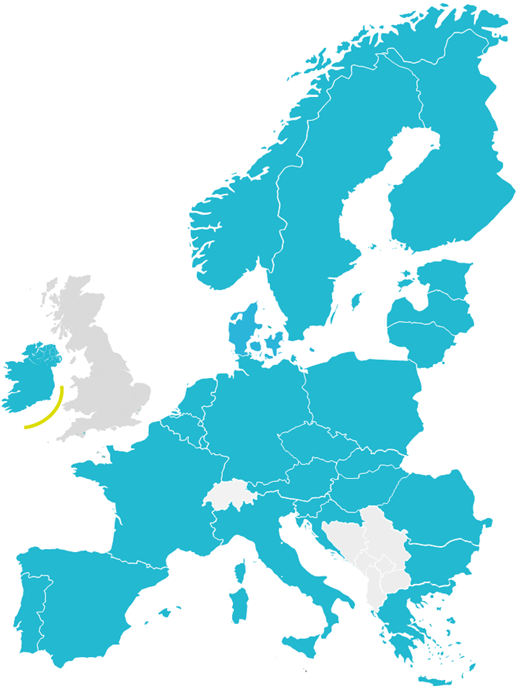SDAC
The aim of Single Day-Ahead Coupling (‘SDAC’) is to create a single pan European cross zonal day-ahead electricity market. An integrated day-ahead market increases the overall efficiency of trading by promoting effective competition, increasing liquidity and enabling more efficient utilization of generation resources across Europe.
It is an initiative started in 2020 between Nominated Electricity Market Operators (Nominated Electricity Market Operator, 'NEMO') and Transmission System Operators ('TSO').
SDAC, as part of the implementation of the CACM Regulation, enables cross-border trading across Europe through implicit day-ahead electricity supply auctions, thereby allocating limited cross-border transmission capacity in the most efficient way by coupling wholesale electricity markets from different regions of Europe using a common algorithm, while simultaneously taking into account cross-border transmission constraints and thereby maximizing social welfare.
SDAC relies on the Price Coupling of Regions (‘PCR’) solution developed and managed by a group of power exchanges. PCR is open to any European power exchanges that would wish to join. More detailed information can be found here.
The project is established on the basis of approved MCO plan (more information in the All NEMO Cooperation section) as a default solution for the implementation of the SDAC.
Geographical scope of SDAC
Until June 2021, the implementation of CACM consisted of two parallel and equal market coupling projects: the Multi-Regional Coupling (‘MRC’) and the 4M Market Coupling (‘4M MC’). The MRC project was introduced in May 2014 by coupling the North-Western Europe ('NWE') Price Coupling and the South West Europe ('SWE') region. In November of the same year, the 4M MC project covering the Czech Republic, Slovakia, Hungary and Romania was launched. The two regions have been fully coupled since June 17, 2021, thus completing the DE-AT-PL-4M MC project, also known as the Interim Coupling Project (‘ICP’). As part of the ICP, implicit capacity allocation based on the NTC (Net Transfer Capacity) method was introduced at 6 borders (PL-DE, PL-CZ, PL-SK, CZ-DE, CZ-AT and HU-AT borders).
In 2022, flow-based implicit allocation was introduced via the Core Flow-Based Market Coupling project (‘Core FB MC’) as the target solution for Europe SDAC required by the CACM Regulation.

Figure 1 - Countries involved in SDAC as of July 2024 (available on the NEMO Committee website)
Countries involved in SDAC as of July 2024 (available on the NEMO Committee website).
How SDAC works
Day-ahead market coupling requires processing input data from all involved NEMOs and TSOs (essentially bids, offers, network capacities and constraints), matching them by using the single algorithm, and finally validating and sending outputs (such as matched trades, clearing prices, and scheduled exchanges) back to NEMOs and TSOs. These steps follow precise and tight time intervals according to binding procedures in order to ensure optimal economic solutions, high performance and robustness.
The SDAC uses a common price coupling algorithm called PCR EUPHEMIA (Pan-European Hybrid Electricity Market Integration Algorithm) to calculate electricity prices across Europe and implicitly allocate cross-border capacity. as defined by the CACM Regulation (Commission Regulation (EU) 2015/1222 of 24th July 2015 establishing a guideline on capacity allocation and congestion management).
The EUPHEMIA algorithm is also used as a technical solution within the SIDC for intraday auction calculation. More about intraday auctions here.
More information on the PCR EUPHEMIA computational algorithm can be found here.
Future development
Regardless of current usage, PCR EUPHEMIA is constantly being updated and developed in order to support further extensions of the market coupling and ensure a higher quality of performance. The main aspects of algorithm development include the following:
- geographical extensions and market growth,
- requirements arising from the CACM Regulation for the algorithm: adequate performance, scalability and repeatability of results,
- new NEMOs’ and TSOs’ requirements,
- network topology changes and
- potential co-optimization of transmission capacity allocation also for cross-border ancillary services.
In 2019, the so-called Euphemia Lab was therefore established as a joint initiative of NEMOs and TSOs. It is a research program (Research & Development, 'R&D') where various possibilities for improving the functioning of the algorithm are investigated, while the research includes both basic heuristics (software) and hardware – architecture, or market design incl. products. In summary, possible solutions to improve target indicators are being explored in the Euphemia Lab; priority is to fulfill the requirements specified in the CACM regulation. Usually at least a year passes between the beginning of the research process and the subsequent introduction into the production environment, which is mainly due to the need for new functionality and thorough testing of the necessary improvement. All regulatory bodies, ACER and stakeholders are regularly informed about the results of the research program.